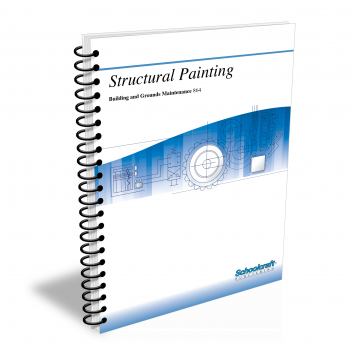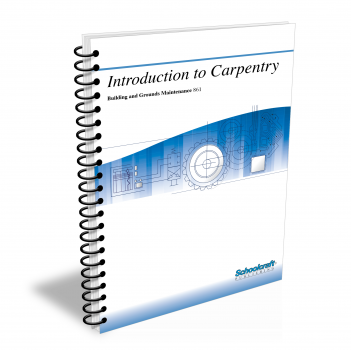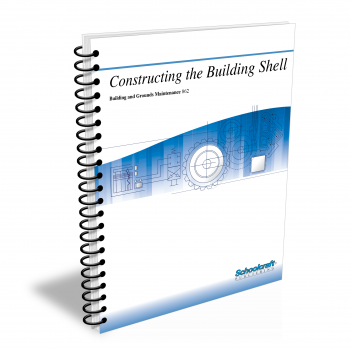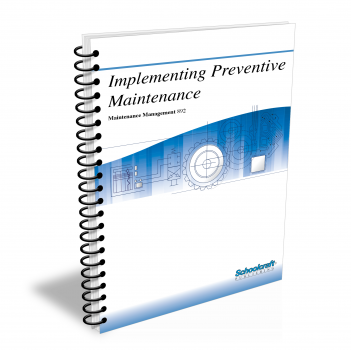Structural Painting

Course Number: 864
The Structural Painting textbook covers the techniques of selecting and applying paints and coatings to buildings, inside and out. It describes the composition of paints and other coatings, and how to use brushes, rollers, spray guns, and other tools of application. It also describes how to prepare new and existing surfaces for coating, and explains the easiest, most successful techniques of application.
Does your curriculum require additional topics not included in this textbook? Build a customized version of the Structural Painting textbook below.
Recommended Contact Hours – 14
Preview a Chapter
Available Supporting Material
- Table of Contents
- Exam Copies
- Suggested Titles
Table of Contents
Chapter 1: Paint Selection for Normal Conditions
Topics: Ingredients and types of paints; Coating selection; Substrate; Ferrous and nonferrous metals; Concrete; Wood; Environmental conditions
Learning Objectives:
- Explain the three basic reasons for using paint.
- Identify the ingredients of paint and explain the importance of each.
- Name several generic paint types and describe their uses in normal industrial applications.
- Compare the characteristics of ferrous and nonferrous metals, concrete, and wood as substrates.
- Discuss environmental factors that influence paint choices.
Chapter 2: Coatings for Extreme Conditions
Topics: Corrosion; Galvanic coupling; Storage tanks; Waste-treatment, chemical, food, and beverage plants; Safety markings; Pipe identification
Learning Objectives:
- Give at least four examples of extreme workplace conditions.
- Explain the electrochemical process of corrosion and its effect in a galvanic coupling.
- Identify some paint types used for storage tanks and in waste-treatment plants.
- Discuss coatings appropriate for chemical plants and various areas of food and beverage plants.
- Explain the meaning of the colors used in the standard safety and piping codes.
Chapter 3: Painting Tools
Topics: Brushes; Rollers; Spray application; Air spray guns; Airless sprayers; Blasting equipment; Abrasives; Testing; Inspection
Learning Objectives:
- Describe the different types of paint brushes.
- Explain the uses of different roller constructions and different lengths of roller nap.
- Discuss the various types of spray equipment.
- Compare the different types of blasting equipment and the abrasives used with them.
- Explain how film gauges, holiday detectors, and surface profile devices work.
Chapter 4: Surface Preparation
Topics: SSPC and NACE standards; Chemical cleaning; Cleaning with hand, power tools; Abrasive blasting; Concrete prep; Special surfaces
Learning Objectives:
- Discuss the importance of correct surface preparation and compare SSPC and NACE standards.
- Compare the various methods of chemical cleaning.
- Name the hand tools and power tools used for cleaning.
- Explain the characteristics and applications of the different grades of abrasive blasting.
- Describe surface preparation techniques for concrete, galvanized metal, wood, mildewed surfaces, and chain-link fencing.
Chapter 5: Painting Techniques
Topics: Mixing and thinning; Brush, roller, and spray application; Blasting; Coating failure; Calculating coverage; Follow up; Records
Learning Objectives:
- Describe correct mixing and thinning methods.
- Point out the dos and don'ts of brush and roller usage.
- Explain how to use and troubleshoot spray equipment correctly and how to set up blasting equipment.
- Discuss the causes of common coating failures and explain how to prevent them.
- Calculate estimated coverage and keep satisfactory records.
Chapter 6: Ground and Aerial Supports
Topics: Safety rules; Using ladders; Scaffold planking, Ropes and cables; Stationary and portable scaffolds; Rigging safely; Lifelines
Learning Objectives:
- Explain the importance of attitude in preventing injury, and how heat, cold, wind, and heights can be dangerous.
- Compare different types of ladders and tell how to use them safely.
- Discuss stationary scaffolding and accessories.
- Describe boom and scissors lifts and tell how to use them safely.
- Compare bosun's chairs, work cages, and swinging scaffolds and platforms.
- Point out safety measures necessary when using cable-supported or suspended units.
Chapter 7: Handling Hazardous Materials Safely
Topics: Fire hazards; Explosives; Fire prevention; Health hazards; Toxic, dermatic materials; Respiratory protection; Protective clothing; MSDS
Learning Objectives:
- Explain how painting materials cause fire or explosions and tell how to reduce these hazards.
- Define six categories of health hazards and name ways to avoid them.
- Give examples of toxic and dermatitic painting materials and explain the purpose of threshold limit values.
- Compare types of respirators and their uses, and list the rules for working safely in confined spaces.
- Describe appropriate uses for safety clothing and tell how to use an MSDS.
Request Exam Copies
Exam Copies
Ready to see a copy of our textbooks? After selecting which textbooks you’d like to review for your course, you can submit your request by either logging in or creating an account so we know where to ship your exam copies. A representative from Schoolcraft will contact you to confirm and finish processing your request.
Exam copies are always free and yours to keep.
Selected Exam Copies
none selected
* Maximum of five copies can be ordered




